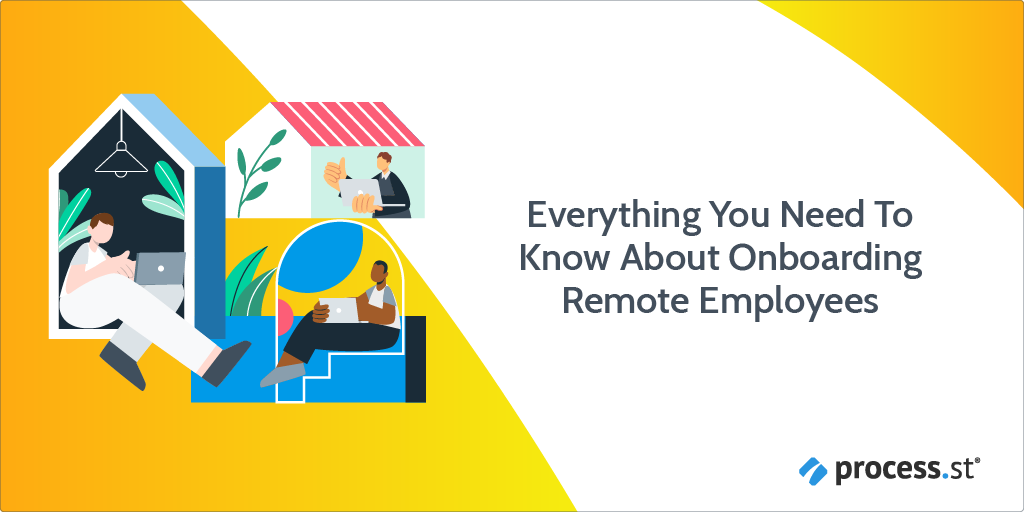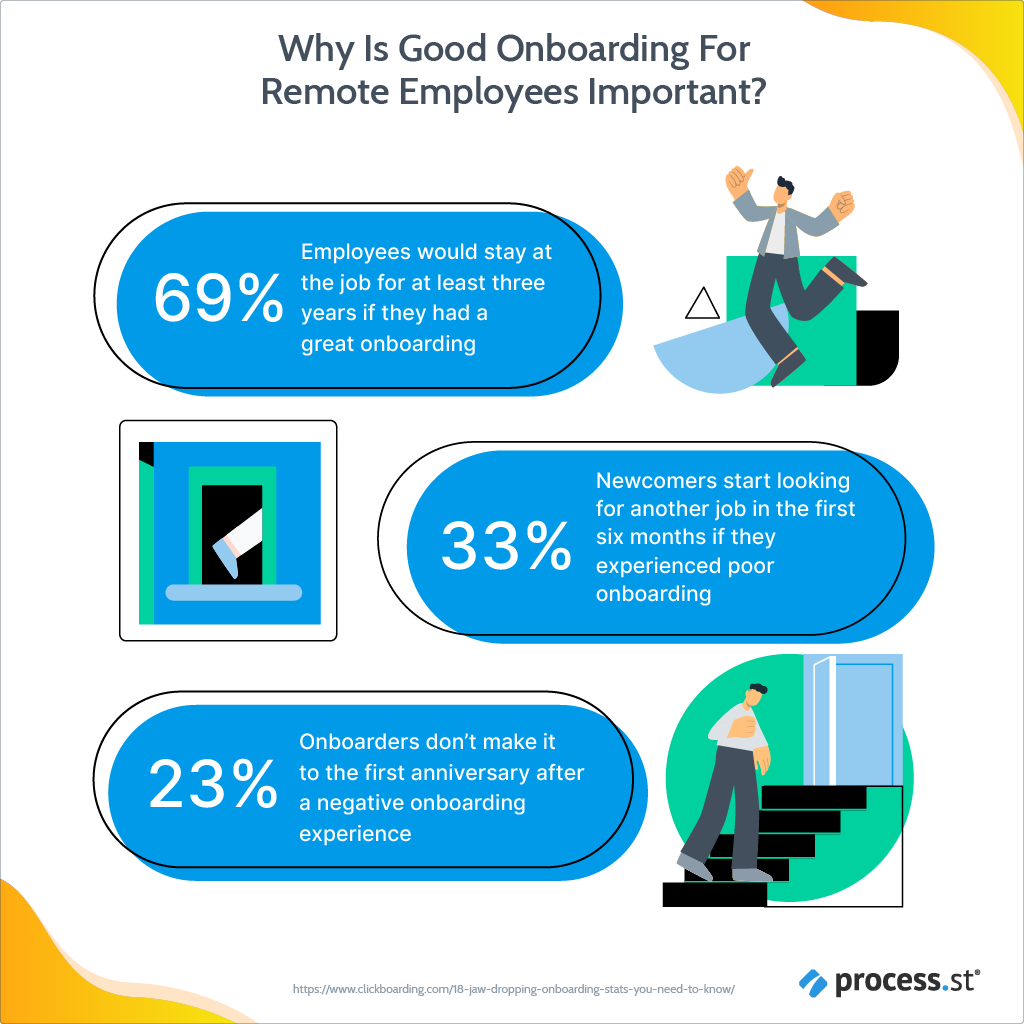
What was once the exception has now become a common workplace model throughout the world. Since 2005, remote working has increased by 159%. Without a doubt, those numbers saw a massive jump with the 2020 COVID-19 outbreak.
This new way of working (and living) is here to stay. Why? Remote work can offer increased employee productivity, reduced churn, and decreased absenteeism, and much more. But these benefits are only within reach when you’ve set up a good remote workplace.
One way of enforcing an effective remote workplace is during the onboarding phase. You can familiarize new hires with the correct resources and processes from the get-go. Just as onboarding is a good way to integrate your employees into a remote working environment, it can also be your biggest downfall if not conducted properly.
That’s why, in this Process Street article, I’m taking you through everything you need to know about onboarding employees in a remote environment.
- The complete onboarding checklist for remote employees
- Embracing the remote work model
- Why is onboarding for remote employees important?
- Onboarding remote employees: Best practices
- Staying connected in a remote work environment
Let’s get ready to onboard!
The complete onboarding checklist for remote employees
There’s no time like the present to start remote onboarding, which is why this pre-made template is a great timesaver. To help you streamline the process, we’ve set up a template filled with tasks and checkpoints. It’s designed to guide your onboarding experience from before your new hire’s first day all the way up to their first month.
With task assignments, you can bring in whoever you want to help with the process, making it collaborative. You can also set off dynamic due dates for tasks you need approved by a specific date. Need to add another task? Add the template to your library and edit whatever you need to ensure your onboarding process is specifically tailored for your business’ remote employees.
When running the workflow template, you have:
- Tasks to help your new hire access the necessary tools;
- A reading list;
- A welcome meeting with the team;
- An assigned mentor;
- A list of team members to help start building valuable relationships.
All of these tasks are included to help set your new hire up for success from their first day.
Embracing the remote work model
Yes, remote working isn’t a new concept. Our team at Process Street has been working remotely since the beginning. But in-office work was the norm for most businesses until the pandemic forced everyone into their homes and they needed to adapt to working remotely.
Before the COVID-19 pandemic, in-office working wasn’t exactly seen as being problematic for the common worker. The typical 9-to-5 employee commuted to and worked in their office workspace without a clear need for change.
Despite the immediate transition to remote working and the initial challenges caused to businesses (and their employees), the benefits of this work model have astounded leaders and workers alike. From a better work-life balance, remote working can also:
- Increase productivity and engagement;
- Offer great flexibility;
- Boost overall job satisfaction and motivation;
- Reduce employee churn.
To have a successful remote work model, you need to educate your employees on the policies and processes they need to follow when performing their work. Effective remote onboarding can do just that.
Why is onboarding for remote employees important?

Remote onboarding gives your new hires a taste of what it’s like to work in this type of environment. This helps set expectations for what they’ll need to do in their role. Overall, it sets a standard that they should follow.
So, if your communication is weak and your onboarding is unclear, that’s the idea you’re giving them to follow. But, that’s for all onboarding: in-office, hybrid, and remote.
One of the biggest issues is that onboarding can be confusing and fragmented, focusing on the process rather than the new hire. Yes, these problems arise for any form of onboarding, but it’s especially problematic for remote onboarding.
Remote working offers increased autonomy, which is great when employees know what they need to do and communication is clear. But if your communication channels aren’t effective, your new hire can quickly become confused about what they need to do and how they should be doing it.
A lack of clear guidance, collaboration, and communication can quickly lead to dissatisfaction, reduced engagement, and ultimately, heightened turnover. This is particularly troubling when you consider that only 12% of employees say that their company offers a good onboarding experience.
We already know about the amazing benefits of remote working, but it’s also clear how catastrophic this environment can become if remote employees aren’t onboarded correctly.
A comprehensive onboarding process is vital because you need to empower them to think remotely while also giving them the information they need to effectively perform their jobs.
When you offer a remote onboarding program that anticipates the needs of your new hires, is heavily documented, and is continuously improving, you help make your team members as much as 54% more productive and committed to your business.
Onboarding for remote employees: Best practices
Here are some tips for onboarding remote employees so that you can make them more productive quicker:
- Get started as soon as possible ⏰: Completing your onboarding paperwork before your new hire’s first day saves time and helps you create a welcoming experience focused on the employee instead of the process.
- Get your new hire set up online early : Provide access to different company software (Slack, Google Drive, Loom, Zoom, etc.), send their company email and passwords, and anything else they will need to get familiarized with before they begin work.
- Provide your company culture and employee handbook : Offering this documentation helps the new hire gain insight into the organization and integrate into existing procedures.
- Practice autonomy : By doing this, you can clarify expectations, set goals, and give them the freedom to decide the best course of action in achieving these standards, which helps them get accustomed to the procedures of remote working.
- Provide your onboarding template (with check-ins) : Your new employee is informed about what tasks are involved in their onboarding and what they’re responsible for and how to go about completing them.
- Encouraging connection : Hosting virtual breakroom games and having a meet-and-greet can help make your new employee feel welcome while providing the opportunity for them to begin building a rapport with their team members.
Onboarding for remote employees vs. office employees: What’s the difference?
Remote onboarding is self-guided and lacks the real-time, in-person interaction that office employees have. As you can imagine, a lot of things can slip through the cracks in remote onboarding and go completely unnoticed by managers and team members.
You’re not going to see if your new employee is struggling at their desk for hours on end trying to understand how something works because you don’t share the same office space. That’s why a comprehensive onboarding process is even more important for remote workers.
It’s to be expected that new hires don’t know everything and things might be lost in translation between the onboarding documentation and the new hire. That’s why having a clear communication channel is necessary.
When I began my onboarding here at Process Street, I had some troubles about this or that. It’s to be expected during those first few months. But as soon as I didn’t really get what was going on, I knew I could jump onto Slack, send a message to my lifesaver, Leks, get the answer I needed, and carry on with my day without any problems.
Staying connected in a remote work environment
Remote employees can quickly feel disconnected from their colleagues and the company as a whole, especially when they’re first starting out in a new role. Providing a clear set of expected outcomes and responsibilities helps ensure your new remote employee can plan and prioritize their work.
Having clarity and good communication from the get-go creates an invaluable foundation for new hire success. Otherwise, a rocky start can break your new hire’s confidence and have your business questioning the capabilities of the employee.
A good remote onboarding process is what sheds light on any uncertainties remote workers face. Effective communication channels then turn such uncertainty into clear understanding, making your new hire more productive, quicker.
A simple workflow management tool, like Process Street, empowers you to offer this clarity and communication through standardizing and streamlining your onboarding processes. But onboarding is the first point of contact. Connection is ongoing and helps you continue strengthening your remote employee’s performance, relationships across departments, and cultural alignment to your organization.
What do you think is most important for remote employees during onboarding? Let us know in the comments below.







 Workflows
Workflows Projects
Projects Data Sets
Data Sets Forms
Forms Pages
Pages Automations
Automations Analytics
Analytics Apps
Apps Integrations
Integrations
 Property management
Property management
 Human resources
Human resources
 Customer management
Customer management
 Information technology
Information technology



Grace Donaldson
Grace is a content writer with a thirst for knowledge and coffee. You'll find her reading in a small café or singing at a rundown jazz bar when she's not overconsuming coffee or compartmentalizing her thoughts into a blog post.